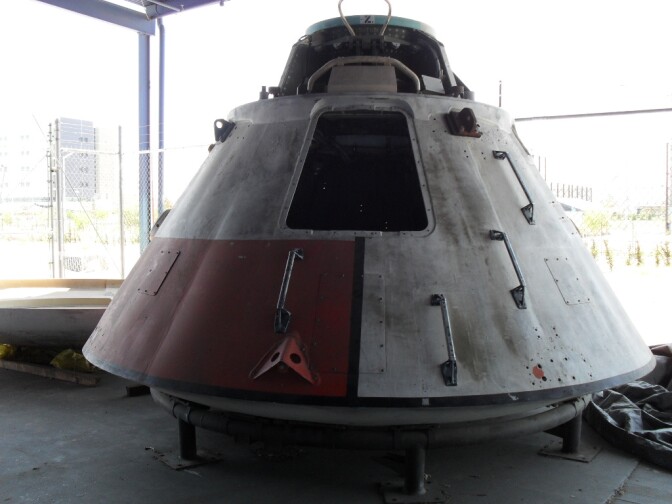Truth matters. Community matters. Your support makes both possible. LAist is one of the few places where news remains independent and free from political and corporate influence. Stand up for truth and for LAist. Make your year-end tax-deductible gift now.
This archival content was originally written for and published on KPCC.org. Keep in mind that links and images may no longer work — and references may be outdated.
Southern California engineers built Apollo spacecraft
Before that “giant leap for mankind” 40 years ago today, a hundred-thousand small steps guided American astronauts toward the moon. Many of those steps originated in the Southland. KPCC’s Washington Correspondent Kitty Felde has this story about how the Apollo 11 command module got to the Smithsonian Institution via the moon... and Downey, California.
Countdown Announcer: Six, five, four, three, two one, zero, all engine running. Liftoff! We have a liftoff. Thirty-two minutes after the hour. Liftoff on Apollo 11.
Kitty Felde: The world watched as three astronauts, Michael Collins, Buzz Aldrin, and Neil Armstrong, left the earth for the moon in a space capsule smaller than an old Volkswagen Beetle.
Jerry Blackburn: You knew what it was like for them to be laying in that crew seat in this confined area because we’d done it too. I mean, we’d been in there too, building it.
Felde: Jerry Blackburn is president of the Aerospace Legacy Foundation.
Blackburn: I was one of the Apollo engineers.
Felde: For 35 years, Blackburn worked at North American Aviation in Downey. That company won the NASA contract to build the Apollo command module, and the service module that provided fuel, water, and oxygen for the lunar journey.
During the 1960s, as many as 50,000 people worked at the Downey plant. It didn’t have enough parking, or enough buildings. Engineers crowded into double wide trailers. Blackburn says they started their project from scratch.
Blackburn: When we won the contract to go build Apollos, nobody had ever done that before. And so there was no book on the shelf that you went to and said here’s how you build a spacecraft. We had to start with building cardboard models.
So we actually built full-scale mockups, they are called, out of cardboard and wood to see, well, what would it look like, and how big would it be, and how would you get in, and where would the switches and panels be, where do the windows go?
Felde: Engineers tested their ideas on boilerplates – metal shells that couldn’t go to space. They built an enormous water tank to test ocean landings.
Blackburn: We wanted to be very safe and cautious. Because the program was a very, very dangerous program. And there were a lot of risks associated with it.
Felde: Failures, too – small ones and horrible ones. In 1967, a flash fire inside a command module killed three astronauts on the launch pad. That led to more safety modifications. In October 1968, the first Apollo mission left the earth. Nine months later, Apollo 11 lifted off for the moon. Jerry Blackburn remembers the launch.
Blackburn: You were excited about gee, we finally built and we’re going to see it work. Hopefully. There was some anxiety. We hope it’s going to work. We hope that every decision we made was right.
That we found all of the problems and solved them correctly and made all the right decisions. And then there’s this anticipation. Of oh, my gosh, nobody’s ever been there before. So what are we going to see?
Felde: What they and many others saw in that grainy footage from space was a cold and lonely place called the moon, coated with chalky dust and chunks of ancient rock.
[Sound of museum]
You can still see and even touch one of those moon rocks at the Smithsonian’s National Air and Space Museum in Washington. You can also peer inside the command module that took the Apollo 11 astronauts to the moon.
Allan Needell: What’s really extraordinary is how many pieces were designed simultaneously, all of which had to work together in an incredibly integrated fashion.
Felde: Allan Needell is the Smithsonian’s curator of space history. He guides a visitor to the charcoal-colored bottom of the command module, designed to protect the astronauts during reentry into earth’s atmosphere.
Needell: If you look up very close, you can see that it’s filled into little cells of a honeycomb material made out of stainless steel, and each of these was filled with a caulking gun by hand. And also after they filled these, they would go through x-rays to test to see if there were little voids left in there, because if there were, they could endanger the spacecraft.
Felde: Needell says NASA engineers working on a new generation of spacecraft tried more modern techniques. But they returned to the technology invented four decades ago. Apollo engineer Jerry Blackburn is proud of his contribution to the challenge President John F. Kennedy posed to his generation.
Blackburn: It was very easy for JFK to sit there and say, “You know what? We’re going to the moon, ladies and gentlemen. And we’re going there because it’s a hard thing to do.” And that was really right. It was hard. It was so hard, we didn’t know how to do it. So we had to figure it out.
We had pencils and we had our brain. And with those tools, we put three men on the moon. We actually put a dozen men on the moon.
Felde: An Apollo command module that helped carry astronauts is on display at the California Science Center in Los Angeles. The first module to fly, “Boilerplate #12,” will go on display this fall at the Columbia Space Center – on the grounds of the old North American Aviation plant in Downey.











